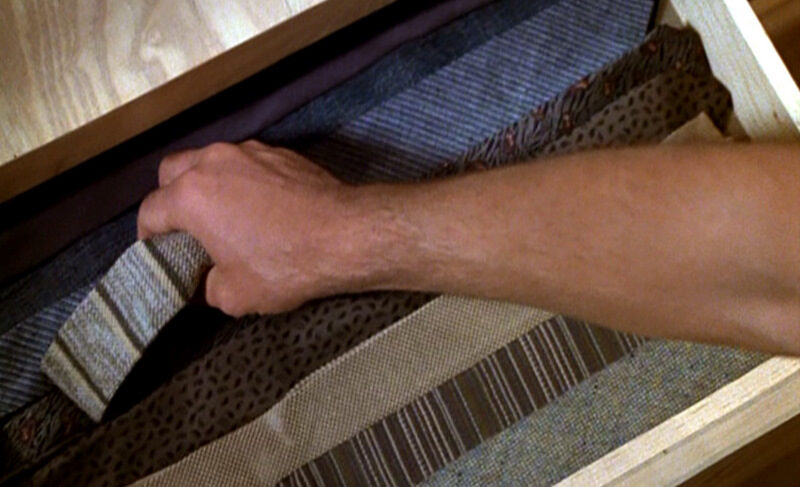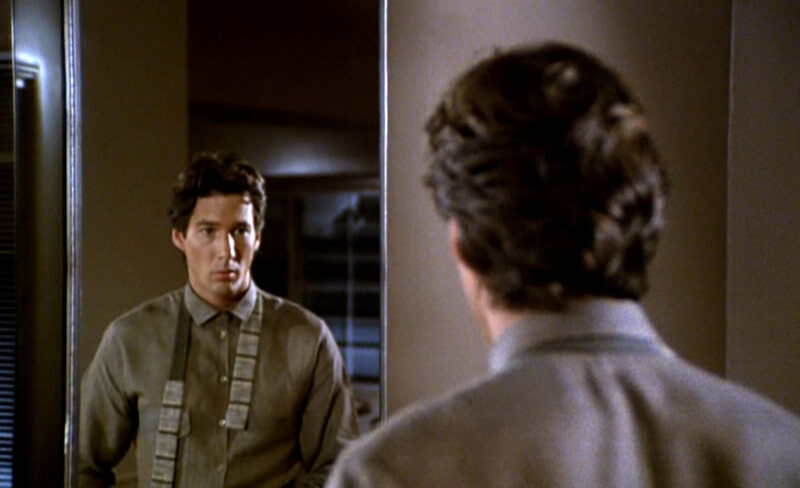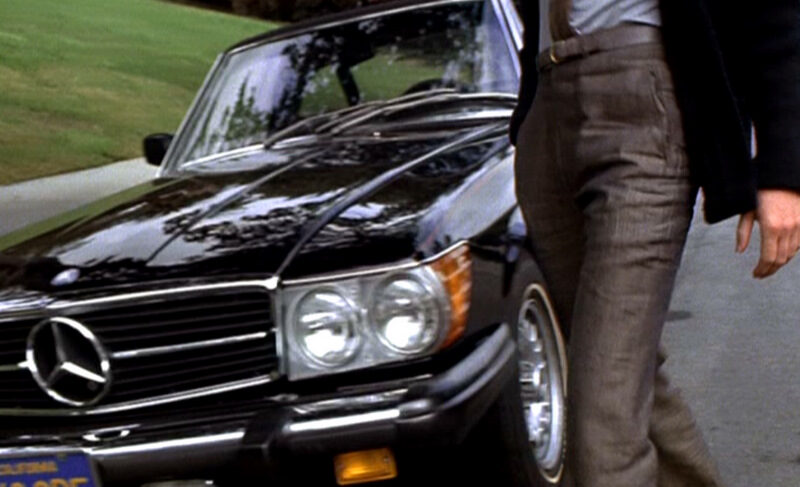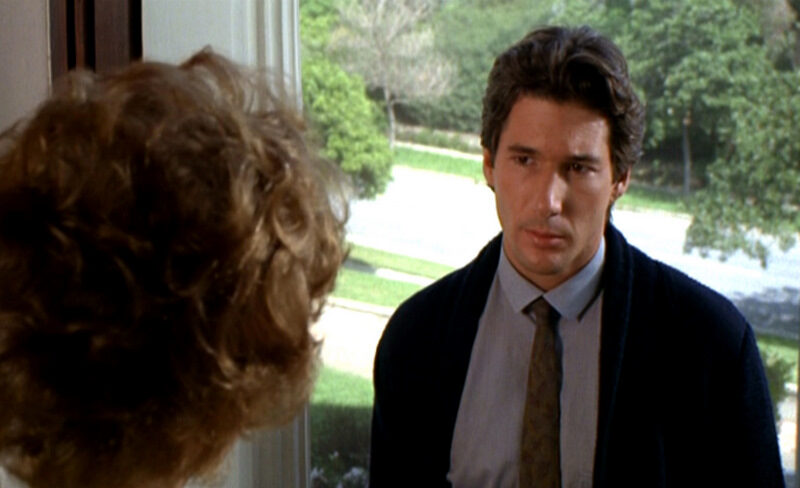American Gigolo: Armani Gere |
American Gigolo (1980, directed by Paul Schrader) is a vapid expression of style without substance that has somehow become an academic’s favourite. Yet to argue the emptiness of the film and its bland protagonist as subtext is to miss the big picture: American Gigolo is not even about its protagonist; it is about what he wears. American Gigolo is about Armani.
It was Italian designers who led a revolution in tailoring during the early 1980s, reinventing the male suit by removing hitherto essential padding for a lightweight, almost floppy silhouette. Combined with unusual fabric choices and bold colours, they defined the decade. Giorgio Armani was at the forefront of this revolution, certainly in terms of bringing it to the masses. Moreover, his clothes were just as popular with both sexes, the GA logo coming to symbolise luxurious excess disguised as simple class.

Armani trained with Nino Cerruti before becoming established under his own name in the late 1970s. Originally his garments were designed to accentuate men of a muscular build, but following French couturier Daniel Hechter’s lead in the mid-seventies, he changed direction. In 1980 Armani introduced long zoot style jackets and heavy trouser pleating, with oversized blousons and mannish tailoring for women.
These components that now characterise the Armani name as relaxed, classic Italian, were showcased in American Gigolo, representing perhaps the most successful brand promotion on film of all time. A suggestion not lost on the designer himself, as rumour has it Richard Gere can still walk into any Armani store and select whatever he wants off the rack for free; he did that much to sell the product.

Although costumed as a whole by Bernadene C. Mann, American Gigolo is all about Armani. In two hours it parades every single line across the screen: formal, semi-formal, casual, daytime, evening, leisurewear, underwear, accessories. The pretext is how these sartorial choices define Gere’s high class prostitute Julian, though really we are watching how his clothes define the Armani name; literally brand creation on film.
While Julian does have a backstory only hinted at during the movie, he is not as appealing as the clothes he wears. This is a perfect fit for Giorgio Armani, who clearly does not want his garments encapsulated by a whore, even if he is an expensive one. It is Richard Gere we recall before his character, and that was what Armani was tapping into. Dress like the star, not the character.

Julian is a narcissist; he enjoys his own appearance and, put simply, is attracted to himself. This leads to an obvious interpretation – that Julian is gay. This may or may not be true; certainly he has undertaken homosexual ‘tricks’ in the past. However this is ultimately irrelevant. It does not matter ‘what’ Julian is, it only matters how he is perceived. With American Gigolo, Armani was not selling a lifestyle choice; he was selling a look.
Julian’s narcissism is exemplified at its fullest as he strolls down L.A.’s designer aisle, laid-back in sports jacket, open neck shirt and jeans. He wants people to notice him just so he can ignore them. Note the way he derides Detective Sunday’s (Hector Elizondo) outmoded street attire then implies that it is not so much his clothes but his face that makes him unattractive. Julian likes to belittle through appearance because it is the only asset he has.

Yet, despite Julian’s questionable personality we still love his clothes. Perhaps implying that a man is not what he wears after all? Or perhaps we do not care about Julian’s disposition and just love Gere for wearing that wardrobe so well?
At risk of appearing hypercritical, there is little point in analysing Julian’s sartorial choices too deeply. Above all else the meaning of these costumes is style not character. It is more worthwhile to appreciate them for fashion’s sake. With this in mind, here is a selection of the most significant outfits Richard Gere wears in the movie and what it meant to the future of fashion that Armani* very shrewdly chose them:

Sports Jacket
As worn for Julian’s first meeting with high profile but lonely housewife Michelle (Lauren Hutton), whose clothes are made by Basile, although still similar to Armani in contruction. Julian’s single breasted, golden brown wool cashmere jacket is long in the skirt, ventless, with high notched lapels and prominently shaped shoulders. The silhouette is a combination of 1930s ‘New Deal’ muscular torso and 1940s zoot suit.
Later when Michelle arrives unexpectedly at Julian’s apartment, he wears a double breasted light grey flannel jacket with sporting-like yoke detail. Here the shoulders look even more defined; his hand on hip gesture causing the angular box shaping to jut out even further.
Interesting, in reference to the brown jacket, Julian wears his as a less austere alternative to the plain black chauffeur suit; interesting because throughout the 1990s, Armani was largely recognised for his plain black unadorned suit above all else.

Sunglasses
These are based on 1950s-era Ray Ban Wayfarer style, only with far larger frames and in a lighter tortoiseshell finish. Still coveted, but undoubtedly look better on Richard Gere than practically anyone else in history, onscreen or off.
Designer eyewear really hit its stride in the eighties, with movies such as American Gigolo and Tom Cruise’s breakthrough Risky Business (1985) selling the attitude that built the decade: conspicuous consumption was nothing to be ashamed of.

Linen Jacket
Cool in natural Italian linen, Julian meets ex-pimp Leon (Bill Duke) to report back from his ‘rough trick’. There is a sultry quality to linen that is instantly relaxing to the eye. Before Armani dressed Richard Gere in this unstructured, half-lined, rather longer than typical ventless version with grey shirt and pleated grey trousers, linen was hardly used for suiting in couture, with lightweight tropical wool normally chosen instead. From humble beginnings as a shirt fabric before the mid-19th century, linen is now regarded as something of a luxury, a concept that Armani’s American Gigolo typifies – owning a look for every occasion.
Being as it crumples so easily, especially the softer Italian yarn, few choose to wear linen on a regular basis. Some consider the creases to be a handsome characteristic of the fabric, others an ugly side-effect. A consumerist, conspicuous man such as Julian would probably view the fabric as demonstrable means. This is the Armani extravagance. Having an Italian linen suit in your rotation proves that you can afford it.

Cardigan, Shirt and Tie
A pale blue turndown colour shirt with the decade’s soon to be crucial short collar points, skinny patterned tie and ribbed shawl neck cardigan, worn with high waist linen mix trousers and leather Chelsea boots by Roots. At this point in the story, Julian’s life is beginning to deconstruct. Picked from a line-up in a murder investigation he rushes to the home of a wealthy, married client in an attempt to prove his alibi.
The inference here is that Julian’s attire reflects emotional changes within himself. He is getting sloppy, less ordered, irrational even. Yet from a historical perspective his outfit is still deemed ‘proper’, the shirt and tie a direct signifier of someone who is controlled in their dressing.
In fashion terms the eighties were about colour and texture. This is a good example of how the latter, a thick fisherman’s rib, has evolved from sportswear to fashion wear. Armani was an innovator in this respect too. Not only did he change the way we wore suits – for a full decade at least – he also evolved the traditional rules of formal/non-formal. Julian’s cardigan, shirt and tie are reminiscent of Albert Finney’s attire from Two For The Road (1967), and more recently a similar look was seen on Daniel Craig in Quantum of Solace (2008) and The Girl With the Dragon Tattoo (2011).

Tuxedo or Dinner Suit
Depending on where you reside, either in North America or the rest of the world, the tuxedo or dinner suit has been prescribed formal attire for over 150 years. It has changed little in this time, only in the gradual reduction of tail coat to frock coat to lounge jacket. Correct dress is presently the same as it was in 1980: white poplin shirt, wing collar or turndown, in plain front or pleated; black bow tie and black suit, single or double breasted with silk faced lapels or shawl collar. Wearing a tail coat in all but the most ceremonial of occasions died out after World War II.
Keen as ever to stamp his identity onto an ensemble, Giorgio Armani added a less common waistcoat to Julian’s dinner suit to fit under his single breasted jacket, that featured peaked lapels and a distinctive hand fastened black bow tie in crushed velvet. Although, in actual fact this is the one time Julian unavoidably becomes part of the crowd. He is used to being the centre of attention, yet there was only so much Armani could play with in Gere’s costume and still call it formal attire, which for this very public segment of the narrative it needed to be.

Sports Jacket and Jeans
This is a look that only existed from the 1980s onwards. Again shifting sartorial boundaries, in this instance between semi-formal and casual, Julian’s wool jacket nonchalantly slung over his shoulder and fitted, slightly retro pressed jeans; open neck shirt with sleeves rolled up and tortoiseshell sunglasses, is a classic crossover of Italian class and American prep.
Denim entered fashion mainstream during the 1970s. After a fifties rebellion of U.S. teenagers donning thick selvedge turn-ups and capri pants to upset mum and dad, now mum and dad owned a pair for themselves. Calvin Klein introduced the so-called designer jean in 1977, closely followed by Gloria Vanderbilt’s clever ‘swan’ branding exclusively for women a couple of years later. Armani was not at the forefront of this particular revolution, though he was one of the first to mix and match fabrics in this way.
Julian is at his most fascinating wearing this ensemble. That arrogant strut denoting total awareness of his beauty. He is a walking, talking tailor’s dummy, yet exudes such unstoppable sexuality that even a beautiful woman will degrade herself into following him in a pathetic disguise and diving for cover every time he clocks her presence.

Black Suit
The black suit is indelibly linked with movies. It is hugely symbolic, though the colour itself alludes different ideas to different stories, characters and situations. Recently it has meant savoir (The Matrix, 1999) or mysterious (Men in Black, 1997) or cool (Reservoir Dogs, 1992). The last example is particularly universal; for whatever else the black suit says about a person, stripped of all sub-textual intention it still projects a single, indestructible value: it looks good.
A certain irony can be appreciated with the suit in question, that those around Julian elicit a less than favourable response, as Leon mocks, “You look like you’ve come from a funeral”. For women, black remained the primary shade for evening wear in the eighties, but for men texture and colour were paramount.
There is a further paradox, in that if Armani, i.e. all the brand has encapsulated during its 35 year history, was reduced to one item it would likely be a plain black suit. Yet Julian is openly mocked for wearing his heart on his sleeve. Evidently the black suit would have to wait another twelve years for its revival in film, and it was the aforementioned Reservoir Dogs, costumed by Betsy Heimann, that achieved it.

Underwear
In short, soft grey jersey, it is worth noting just how much these trunks resemble modern men’s underwear. Any high street clothing store will sell a pair similar to these nowadays. Influence does not always have to be dramatic, sometimes big changes come in small packages, so to speak.
Legacy
Ask most cinemagoers to name five movies with memorable contemporary clothes and American Gigolo is sure to appear on their list. There is no denying that the costumes achieved their goal of facilitating a protagonist whose sole existence depended on the control of his appearance.
Although it was Giorgio Armani who received the ultimate prize; with American Gigolo he created a narrative for fashion – his fashion. This film established the Armani brand, and not just for years to come, but forever.
* Not every item Julian wears is Armani. Look closely and you will see a few other eighties specific designer brands in his closet.
You can watch Richard Gere in American Gigolo at LOVEFiLM.com.
© 2012, Chris Laverty.
